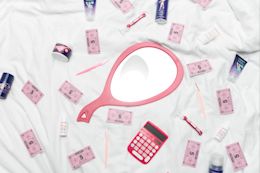
The pink tax: why do women pay more than men for the same products?
The colors blue and pink aren't the only differences between products aimed at men and women: there are also differences in price.
2 min read
From the day we're born, we're aware of the differences between products for boys and girls, men and women, and so on. It's easy to tell—blue for a boy and pink for a girl. That's nothing new. But what will probably surprise many is that not only are the colors different—the prices are too.
International studies are increasingly highlighting that women have to pay more than men for the same product. This might sound absurd at first, but it’s easy to see in hygiene, cosmetic and personal care products. The discrepancy is known as the pink tax, which is nothing less than a business practice that "taxes" products aimed at a female target audience with higher prices. In other words, prices for the female version of a product are higher than those for the male counterpart. All you have to do is visit the supermarket and compare the prices of the same product for him and her. Like deodorants, for example.
In most cases, this extra cost for products aimed at women is simply based on a difference in color: pink. These items work the same way, serve the same purpose, and are used to create the same results. Razors are the most widely-known example. They are separated by are found on separate shelves in supermarkets, depending on whether they’re targeted towards women or men. This deliberate positioning also hides another particularly surprising difference in price: according to FACUA, a Spanish consumer protection association, women's razors are up to 171% more expensive than men's.
Many consumer associations across the world have highlighted this phenomenon. For example, one study in the United States found out that women can spend up to $1,400 a year more than men as a result of this price difference. This has contributed to the rise of gender marketing, which refers to the segmented marketing of the same product depending on the buyer's gender. According to FACUA, this goes against Article 5 of the Spanish Unfair Competition Act, which defines "misleading advertising" as "any presentation that misleads or is likely to mislead the target audience, and is likely to influence their spending behavior, especially in terms of the way the price is set". It also highlights that businesses must respect the principle of equality set out in Spain's Law on the Effective Equality of Women.
Although it's hard to believe, the pink tax can also be found in clothing, hairdressing, beauty treatments, and even laundries: you sometimes find different prices depending on whether the item to be cleaned is men's or women's clothing.
In short, this practice is increasingly spreading to other sectors that use gender marketing to deliberately segment their customer base. This term describes how tampons, panty liners, sanitary pads, and other female menstrual hygiene products are not taxed at the same rate as other products considered basic necessities. In fact, in Spain, these products are subject to 10% VAT instead of the super-reduced 4% rate which applies to all basic necessities.
Many governments around the world intend to reduce or even eliminate this tax, following the example of countries like Ireland, Kenya, the United Kingdom, Australia, India and Canada. This has been a long time coming, as many studies have highlighted the economic discrimination women suffer. Women need to buy products for their menstrual cycle for at least 30 years: it is estimated that a woman spends around 1872 days of her life on her period. The issue is a little difficult in Europe, since the European Union does not allow products to be sold without any kind of tax, meaning the best-case scenario of eliminating VAT altogether seems hard to achieve.
Clearly, there is no good reason for these taxes and there is no quick solution to this discrimination. That's why we at N26 encourage you to take a look at these price differences, to see how they affect you and how you can avoid them. After all, the choices we make as consumers are the best way to express how we feel about these situations, and clearly show our acceptance or rejection of the status quo.
So, what is the tampon tax?
Simplify paying your taxes with N26
Need to file taxes but don’t know where to start? With N26, you can pay your taxes quickly and hassle-free: from income tax returns, self-employed fees, investment and cryptocurrency trading commissions, to expat taxes—everything from the mobile app, without leaving home.
Organize your expenses with personal and self-employed accounts using real-time notifications and smart tools like statistics, so you won’t miss any details of your tax obligations and stay compliant with the tax authorities.
Keep your finances up to date and file your taxes headache-free with N26.
BY N26Love your bank
Related Post
These might also interest youTAXESA simple guide to road tax in SpainRoad tax driving you crazy? Here’s how your vehicle’s specifications determine how much road tax you owe, and how to make your payments. Let’s go!
5 min read
TAXESPaying your self-employment taxes in Spain with your N26 Business accountFind out whether you can pay your self-employment taxes in Spain with N26, and what other features you might want to consider when looking for the right business account.
4 min read


